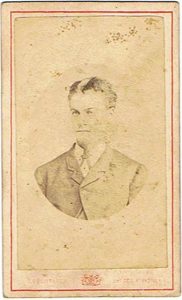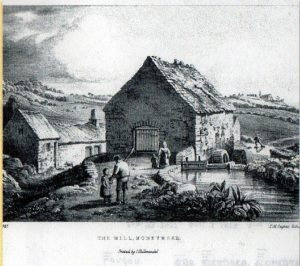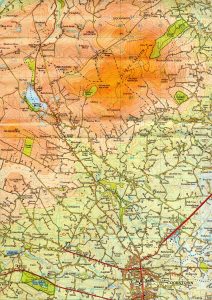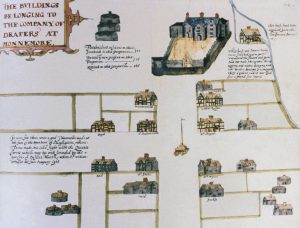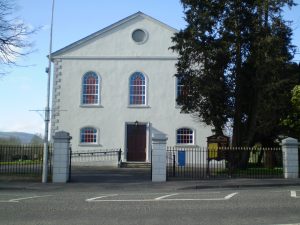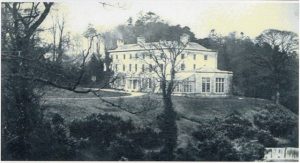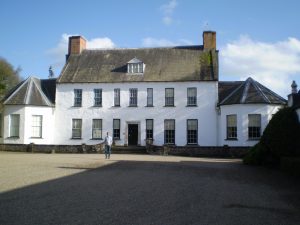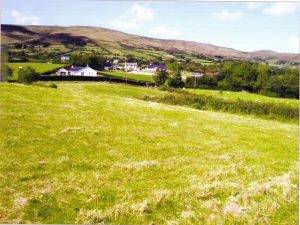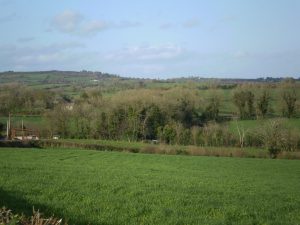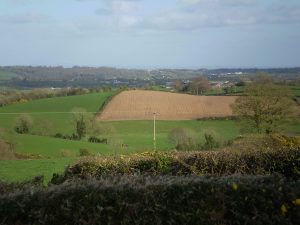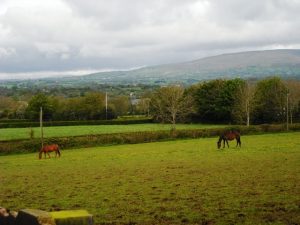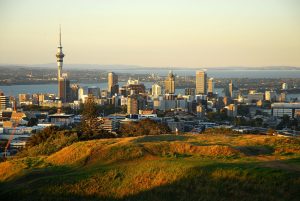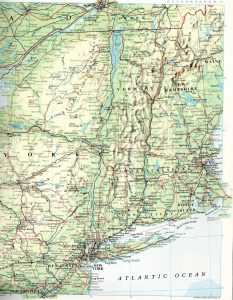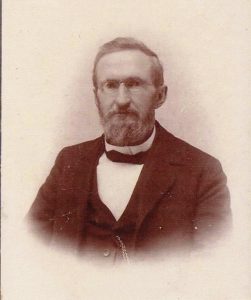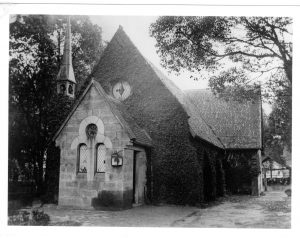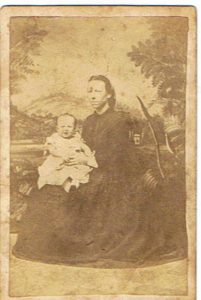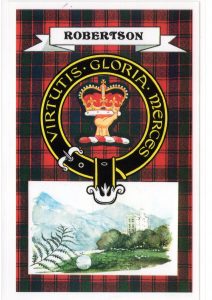
THE REIDS OF KNOCKADOO
Parish of Lissan, Co.’s of Londonderry & Tyrone,
NORTHERN IRELAND
A SHORT HISTORY
J. R. Maitland
(c)20/08/2020
We have updated this Reids of Knockadoo website to include how much more we have found about our extended family since the original site was uploaded. The research has grown from the book The Reids of Willoughby, Australia, pub. in 1995 to the website Reids of Knockadoo established some years ago and now to, A Short History. I will leave further research to other family members.
This page contains several photos, you can click on each photo to enlarge it if you wish.
Knockadoo is a Townland in the Parish of Lissan, in the County of Londonderry, Province of Ulster known as Northern Ireland since the Partition of Ireland on 3rd May 1921. At the time my Great Great Grandfather James Reid was born there in 1818, the whole island was known as Ireland, with its separate Provinces and Counties.
James’ parents were John Reid, Farmer and his wife, Sarah as listed on James’ Shipping Record when he arrived in N.S.W. on 3rd October 1840. Later, in 1876 on James’ death certificate his son, John Reid, gave James’ mother’s name as Jane, but I would think that James’ own record is more likely to be correct. I have taken the details that James and Mary gave on their Shipping Records as correct but there are variations in other records.
James Reid married Mary Barker at Lissan, on 2nd June 1839. Mary b.1818 was “of” Moneymore, County Londonderry, the daughter of John Barker and his wife, Mary. On 24th June 1840 James and Mary Reid sailed from Plymouth, England for Australia. Mary Reid was then seven months pregnant and their daughter, Sarah (Sally) Ann was born at sea near the Cape of Good Hope on 11th August 1840. The Public Record Office of Northern Ireland (PRONI) does not hold a record of the marriage of James & Mary Reid at Lissan Church of Ireland, (there was no Presbyterian Church in the Parish of Lissan at that time). Years ago, the Presbyterian Minister at Moneymore advised me that there were no records for either the Presbyterian or Church of Ireland there, prior to about 1840. They had probably been sent elsewhere. However, there are some on various websites now. Also, around the mid 1800s Presbyterian Ministers were restricted about whom they could marry and where. It was quite common for couples to marry in churches of other denominations.
I have given the name of Robert Reid to John & William Reid’s father, following the Scottish Naming Pattern of “the eldest son is named after the father’s father”. This Naming Pattern was very commonly used in Scottish families at that time however, Robert is only used as a possibility. The name Ann is given to John Reid’s mother also as a possibility although it has not been confirmed which of their daughters, Nancy (Ann) or Jane, was the eldest. Details of the children of John Reid b.c.1773 and Sally Sloan b.c.1780 are given later in the text.
The Plantation of Northern Ireland
The website Lord Belmont in Northern Ireland The Staples Baronets, states: The Staples family settled in Ulster during the Reign of King James 1 of England. Thomas Staples, of Lissan, the founder of the family in the Province, originated from Bristol ca.1610 as part of the Plantation of Ulster, and settled in the town of Moneymore, Co. Londonderry. It appears the Barker family came to Northern Ireland around 1620 from the Bristol area of England (Yate Court) about the same time as the Staples family. On a map of c.1635 the stone house of both Sir Thomas Staples and of Mr. Barker are marked as in the centre of Moneymore, beside the Market Cross.
In Pynnar’s Survey of the Six counties of Northern Ireland 1618-1619 written after the start of the Plantation as a progress report for the Government it says of Moneymore: The chief town, Moneymore, is quite an English town, most beautifully laid out and managed by Mr. Rowley Miller and his son; he kindly showed us through the estate. The inn is one of the best we met with whilst in Ireland. The Company have lately established another town, called Draper’s Town, which is thriving rapidly. There are many thriving plantations of timber here; and the whole appearance of the farm-houses and the town, with the church, the market-house, and other buildings, all indicate the kindness of the Draper’s Company, and of their excellent manager, Mr. Miller. It is also noted in this article that According to the recent The Return of Owners of Land in Ireland, the Drapers hold 27,025 acres, valued at 14,859l See Irish Doomsday Book, 1875.
The Barker family were builders and stonemasons and were responsible for the erection of many of the buildings in the establishment of Moneymore. The Barker’s house and that of Sir Thomas Staples, were two of the first substantially built houses in Moneymore. The Barkers also settled in the Townland of Tullynure and the town of Cookstown. The Draper’s Company was one of the Undertakers (Agents) for the English and Scottish Governments. Sir Robert Staples, 7th Baronet (1740-1816) second wife, was Mary, daughter of Sir William Barker Bt, and had two children, Robert, his successor, and Anna Maria.
The Plantation of Ireland occurred in the early 1600s when the English Government decided that they wanted more Settlers in Ireland of English and Scottish descent. King James I of England, advised by Sir Francis Bacon, preferred the approach advocated by Chief Justice Sir James Ley and Sir John Davies. Their 1609 ‘orders and conditions’ provided the framework for the plantation.
Land was divided into ‘proportions’ of 2,000, 1,500 and 1,000 acres, with three categories of grantee. English and Scottish chief planters (undertakers) had the heaviest responsibilities as regards fortification and settlement. Civil and military servants of the crown in Ireland (servitors), were permitted to have Irish tenants and could have lower rents if they settled the required number of 24 adult English and Lowland Scots per 1,000 acres. This is part of an article from encyclopedia.com under the heading Ulster Plantation, The Oxford Companion to Irish History (2007).The whole article makes for interesting reading.
The Covenanters in Scotland
Apart from the Plantation of Ireland in the 17th Century, from 1609-1670, some of the Scots Covenanters fled to Ireland to escape oppression in Scotland.
Covenanters, in Scottish history, were groups of Presbyterians bound by oath to sustain each other in the defence of their religion. They resisted opponents who tried to force them to accept other forms of worship and church government. In 1581, the first important Covenant opposed efforts to restore Roman Catholicism to Scotland. When King Charles I tried to impose the Episcopalian prayer book and the English clergy on the Scots, they drew up the National Covenant of 1638 to resist him.
In 1643, the Church of Scotland and the English Parliament signed The Solemn League and Covenant, establishing Presbyterianism in Scotland, England and Ireland. But the English rulers ignored this Agreement and persecuted the Presbyterians. The Covenanters were hunted down, beaten, imprisoned, some on Bass Rock in the Firth of Forth in Scotland. The Covenanters continued to fight for their beliefs until finally, in 1690, King William III of England permitted the free expression of the Presbyterian faith in Scotland. (as written by Peter W. Williams in The World Book Encyclopaedia 2009).
One Covenanter, named John Reid, was imprisoned on Bass Rock in the Firth of Forth, Scotland and later sentenced to be transported to the West Indies. After serving his term there he returned and made his home in the Northern Ireland County of Armagh.
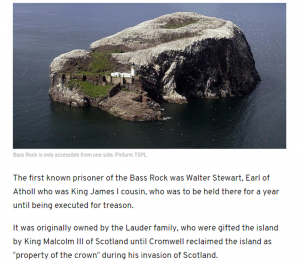
Records searched relating to the Reid families in Knockadoo, Co. Londonderry. It is noted that there is another area called Knockadoo in the County of Sligo, I have not found any reference to “our” Reids in Co. Sligo.
On the Flax Growers Bounty List 1796 for the County of Derry is listed a James Reid at Tamlaght, Finlagan, Derry with many Reeds listed. On the same list there are two listings for a Hugh Barker one at Artrea, (Finlagan) Derry and the other at Lissan, Derry. For the County of Tyrone there is no Reid but again many Reeds, one a John Reed of Lissan, and a Samuel Reed of Bodoney, Upper Tyrone. There is also a James Barker, Bodoney, Upper Tyrone. Bodoney appears to be in the parish of Dromore in 1851 and Kilskerry, Omagh, East Tyrone in1861. The spelling of the surname Reid/Reed occurs often but “our” Reid family seemed to keep to the Scottish version, Reid. With one obvious change with George Sloan Reid’s emigration to Canada & the USA when the spelling changed to Reed, a more American way of spelling the name.
In 1817, after Sir William Rowley had not renewed the Leases he had held for sixty years, including the town of Moneymore, Co. Londonderry administration was taken up by The Drapers Company who had been granted the estate by King James I of England in 1611, although they did not look after the property until after the succession of King Charles II. The Drapers Company of London set about rebuilding and changing Moneymore from what was, by then, a rather run down, into a progressive and prosperous town.
John and William Reid take up Leases in Knockadoo, Co. Londonderry.

It was at this time, 1817, that William and John Reid took up Leases in the Townland of Knockadoo, the Leases being held by Sir Thomas Staples 9th Baronet (1775-1865).
Maybe it was because of the planned rebuilding of Moneymore and the leases made available at that time that John and William decided to settle in Knockadoo, Co. Londonderry. We have not been able to confirm their birthplace, yet. In the 1831 Census of Ireland John and William Reid, allowing for the fact that these were farms, not a town street, were living next door to each other in houses no. 32 and no. 33.
The following details are given for the Leases of John & William Reid.
1. PRONI. D1567/A/12, Extract from Staples Estate Leases.
To John Reid of Knockadoe, 8 acres, 3 roods and 10 perches (probably Irish measure, if so 14a.–1r.-4p. statute/English measure) for 14 years from 1 Nov. 1815 at 12/- per acre (12 shillings per year). Lease dated 22 July 1817, signed John X (his mark) Reid.
To William Reid of Knockadoe, 9a.-0r.-17p. (probably Irish measure, if so 14a.–3r.–0p. statute/English measure) for 14 years etc. as above. Lease dated 22 July 1817, signed William Reid. (signed in a clear but not a practised hand).
2. PRONI. FinV/203, Tithe Applotments, Lissan Parish, 3 Oct. 1827
John Reed, Knockado, 13a.–3r.-39p. Pounds 0-17-6
William Reed, Knockado, 14a.-2r.-0p. Pounds 1-0-1
3. PRONI FinV/533, Valuation Books, Lissan Parish, 1833
John Reed, Knockadoo, House and Offices (out buildings) Annual Valuation pounds 2-15-11
William Reid, Knockadoo, House, Offices and Workshop Annual Valuation pounds 2–15-6 The workshop suggests that William had a trade, possibly as carpenter. If a Blacksmith, probably forge instead of workshop.
Above properties are most likely held on renewals of the 1815 Leases.
On the Ireland Census of 1831, Co. Londonderry, is listed:
Reid John, Head, Par. Lissan, Address, Knockadoe(sic)
Reid William, Par. Lissan, Address, Knockadoe(sic).
I would take it that this is our James Reid’s father, John Reid, and William Reid is believed to be his brother, there was no Barker listed at Moneymore.
Lewis’ Topographical Directory (1837) gives a very extensive account of, and this is only the first paragraph: ARDTREA or ARTREA, (Ardtragh) a parish, partly in the barony of DUNGANNON, county of Tyrone, and partly in the barony of LOUGHINSHOLIN, county of Londonderry, and province of ULSTER; containing, with the district or perpetual curacy of Woods-chapel, and the greater part of the market and post-town of Moneymore, 12,390 inhabitants, of which number, 7471 are in the district of Woods-chapel.
Ordinance Survey Memoirs of Ireland – 1820-1840
Volume 31 of the Memoirs.
Parishes of Co. Londonderry XI, 1821, 1833, 1836-7, South Londonderry.
Parish of Ballynascreen p.16 has a reference under costumes that no Scotch caps appear anywhere, p.21 under Emigration in 1834 lists a James Reid, 30, Roman Catholic, from Glebe to Quebec. Obviously not our James Reid but may be of interest. Under the heading Churches, local tradition says that Ballynascreen ancient church is the centre one of nine churches founded by St. Colum Kille in the north and southern parts of the County Derry and a portion of Tyrone, to wit Ballynascreen, Desertlyn, Desertcreat, Termon and Killelagh, <Killylagh>, Bodoney <Badowney>, Maghera, Magerafelt Dungiven. These churches are called “nie thampelle na ought milie Colum Kille” or “the 9 churches 8 miles one from the other founded by St. Colum Kille”. I have just noted this as a matter of interest.
Parish of Desertlyn p.35 The town of Moneymore is partly in this Parish and partly in the neighbouring Parish of Artrea. There are very good descriptions of Moneymore and its population and surrounds here.
Parish of Lissan p.89-110 is an excellent description of this Parish and the Townland of Knockadoo is mentioned a few times, p.95 re National School held in rented house in Knockadoo. On p.108 under the heading Census (no date) it says Knockadoo, 112 Roman Catholics, 128 Presbyterians, 66 Established church and 10 Seceders. It should be mentioned that many place and locality names in Ireland were repeated so that it is important to know which County the place of your ancestor is from.
List of persons who emigrated in 1834, none from Knockadoo. In 1835 Alexander Carson, 40, Esther Carson, 35, Presbyterians from Knockadoo to New York and Elizabeth Hunter, 25 from Knockadoo to New York. Under Migration of persons who migrate annually from Lissan Parish to Glasgow, Scotland are five Roman Catholic families from Knockadoo. Namely Edward and Bernard Sherry, John McKernan, Christopher, Mary and Nancy McCullagh and Eliza Hagan. People from Northern Ireland migrated annually to Scotland to help with the Scottish Harvest (and obtain work) and then returned to their homes in Ulster in time for their own harvest.
Miscellaneous Papers attached to the Ordinance Survey:
On p.116 when writing of the beautiful scenery in this area it says of the view “from Slieve (Sliabh) Gallion in Antrim Slemish, rearing it’s gigantic head, directs the eye to Knocklead, and, far beyond, like turrets dimly seen on the verge of the horizon, appears some mountains in the Western Isles of Scotland. A good indication of how close Northern Ireland is to Scotland”.
On p.136, Presbyterian Clergy, Succession of Presbyterian Ministers: the first minister of Tobermore was in 1728 Rev’d Mr. Reid, I hope to find out more about this Mr. Reid. I did not find any mention of the surname Barker in this volume.
It does seem to me from reading these Memoirs that the ancestors of James Reid and Mary Barker did emigrate from Scotland to Northern Ireland either at the time of the Plantation or as Covenanters around 1700.
The family would probably have been Flax growers in the late 1700s-1800s as well as crop farmers, renting their small holdings.
The Primary Valuation of Ireland 1848-1864 lists in:
Co. Derry,
Henry Reid, at Knockadoo, Lissan, Derry, James Reid, same details, John Reid, same details and Thomas Reid, same details.
Co. of Tyrone,
Bernard Reid, Broughderg, Lissan, Co. Tyrone and Jane Reid, Drumgrass, Lissan, Co. Tyrone.
There are eight listings for the surname Barker in Derry also eight listings for Barker in Tyrone. The valuation for Ulster was done between 1858 and 1864.
Census details for a few of the families – many Irish Records were lost in some of the Uprisings in Ireland.
The Census of 1901 lists two Reid families living in Knockadoo:
at house No. 10 are:
Henry Reid, Head of Family, Presbyterian, can Read & write, age, 44, male, Farmer, married, born Co. Derry. (Son of John Reid b.1808 & Jane Bell b.1823).
Rachel Reid, Wife, Presbyterian, can read & write, age, 46, female, Farmer’s wife, married, born Co. Derry and some of their children.
Whereas in house No.19 are listed:
Jane (Black) Reid (b.1821), Head of family, Presbyterian, Read & write, age 80, female, Farmer, born County Derry. Jane was the widow of James Reid b.1824, some of their children are also listed.
This James Reid b.1824 was a son of William Reid and Rachel Galloway, as was John Reid b.1808 who with his wife, Jane Bell, also settled in Knockadoo with their relatives. I do wonder if this was a second marriage for John Reid b.1808.
The Belfast & Ulster Towns Directory 1910 lists in the District Inhabitants for Cookstown, Co. Tyrone a James Reid of Tirnaskea, a John Reid of Gortreagh and Samuel J. Reid of Aughleish with no Barkers listed. The same Directory for Moneymore, Co. Derry lists in the Inhabitants a Mrs. Reid, Draper & Outfitter, and a Samuel Reid, Grocer and Farmer, there are no Barkers listed. Knockadoo and Lissan are not listed in this Directory.
The following two listings for the 1911 Census are for grandchildren of William Reid and Rachel Galloway through their son, James Reid b.1824 and his wife, Jane Black b1821.
The Census of Ireland 1911 lists living at house no. 19, Knockadoo, Lissan Upper, Co. Derry,
William John Reid age 54, male, birthplace Co. Derry, Occupation, Farmer, Read & Write, Head of Family, not married.
James Crooks, Servant, Presbyterian, read & write, age 20, Farm Servant, not married, born England.
This Census also lists at house no. 18, Knockadoo, Lissan Upper, Co. Derry,
Nancy Agnes Reid, age 64, Female, Head of Family, Presbyterian, birthplace, Co. Derry, Occ. Farmer’s daughter, Read, (not write), Not married.
Margaret Reid, age 63, Female, Presbyterian, Birthplace Co. Derry, Occ. Farmer’s daughter, read (not Write), not married.
Elizabeth Reid, age 58, Female Presbyterian, Birthplace Co. Derry, Occ. Farmer’s daughter, Read & Write, Not married.
William John’s sisters moved to house no 18 possibly after their mother, Jane Reid, died. Being born c.1850 they would have been nieces and nephews of “our” James Reid, b.1818 and cousins of my Gr. Grandfather John Reid of Willoughby, NSW.
The 1911 Census Listing below is for Henry Reid b.1852 and his wife, and cousin, Rachel Reid b.1849. Henry being the son of Thomas Reid b.1802 and his wife, Nancy (Ann) Reid b.1810, being the daughter of William Reid and Rachel Galloway. These marriages, between cousins, uniting William and John Reids’ families in Knockadoo. The repetition of family names is very confusing and the families at that time seemed to be identified by the name of the town or locality where they lived. Knockadoo is a Townland in the Parish of Lissan.
A descendant of John Reid 1808-1899 and Jane Bell, Rebecca Reid b.1851, married Thomas Davidson of Drumrot, Co. Londonderry, in 1874 at 1st Moneymore Presbyterian Church and soon afterwards emigrated to New Zealand. A descendant of Thomas and Rebecca (Reid) Davidson now lives in Sydney, NSW.
By the Census of 1911, Henry Reid who had lived at house no. 10 at Knockadoo in 1901 had moved his family from Knockadoo to house no. 321 in Beersbridge Road, Upper (Pottinger (part of), Belfast, Co. Down). Shown here are:
Henry Reid, age 58, male, Father, Presbyterian, born Co. Derry, Garden Labourer, read & write yes, married, years married 39, children born 8, children, living 6.
Rachel Reid, age 61, female, Wife, Presbyterian, born Co. Derry, read & write yes, married, same marriage and children details as husband.
William James Reid, age 27, male Son, Presbyterian, born Co. Derry, Ropework Labourer, read & write, yes, Single.
Bella Walker, age 25, female, Daughter, Presbyterian, born Co. Derry, read & write yes, married 7 years, children 2 born, 2 living.
William James Walker, age 28, male, Son in Law, Presbyterian, born Co. Derry, Joiner Shipyard, read & write yes, married same details as wife.
John Walker, age 6, male, Grandson, Presbyterian, born Belfast, Scholar, cannot read no, single.
Samuel George Walker, male, Grandson, Presbyterian, born Belfast, Baby, cannot read, no, Single.
Alexandra(sic) McLoughlin, age 30, male, Visitor, Presbyterian, born Co. Derry, Farm Labourer, read & write yes, Single.
The Census Enumerators Abstracts and the Returns for Out Offices & Farm Steadings give detailed information about exactly what the farms consisted of.
There is previously mentioned that a Covenanter named John Reid, was an ancestor of Rev. James Seaton Reid, I have a copy of James Seaton Reid’s family tree and there is a John Reid there that the compiler did not know what happened to him. There also does not appear to be any information about this John’s brother, William Reid. Both this John Reid and his brother, William Reid may be the two men who took up Leases in Knockadoo in 1817, our relatives. Forrest Reid, of the James Seaton Reid Tree left home in 1817 and emigrated to USA. 1817 was the year The Draper’s Co. resumed their administration of the town of Moneymore and the local area.
We have not been able to confirm that the parents of Sarah (Sally) Sloan, a Henry Sloan b.c.1750 Downpatrick Co. Down appears to be the most likely. His familys’ names and dates do tie up for our Sarah (Sally) Sloan but, I have not found Primary records to confirm those details. The Sloan(e) name does appear in Townlands in the 1831 Census for Co. Londonderry, Ireland.
The children of John Reid and Sarah (Sally) Sloan.
The children of John Reid b.c.1773 and his wife, Sarah (Sally) Sloan are Robert, Thomas, John, Nancy, George Sloan, Jane, Henry and “our” James Reid. Robert Reid married Elizabeth Johnston and moved from Knockadoo to Drumard, Thomas married a daughter of William Reid, Nancy Reid, a cousin. John Reid is believed to have married a Maria Sloan. Nancy married Joseph Johnston and George Sloan, married Jane Sherry, Jane Reid we have no information on yet. Henry married Nancy Ekin, (Eakin) they appear not to have had any children but to have lived in the Moneymore area.
Apart from George Sloan Reid and “our” James Reid, the other children of John Reid and Sarah (Sally ) Sloan appear to have stayed in Northern Ireland but many of their children and grandchildren emigrated to other countries mainly USA, Canada, Australia, and New Zealand. Certainly, the Great Famine of 1845-1848 in Ireland and the political problems in Ireland would have contributed to these departures.
George Sloan Reid 1810-1897, married Jane Sherry 1805-1871, in 1831 in Co. Londonderry and soon after emigrated to Quebec, Ontario, Canada. Later moving over the border to Vermont, USA, where their children were born. The spelling of the surname Reid was changed to Reed when they emigrated, why I am not sure, it could have been just a clerical error by a Shipping Clerk and they decided to stay with it or, as some emigrating families did, they felt that a new spelling of their name in a new country was a new start for them.
I was so pleased when a descendant of George and Jane Reed’s son, Lewis George Reed, contacted me and sent to me a copy of George’s Obituary of 1897 which confirmed that his full name was George Sloan (Reid) b.1810 Ireland and his parents were John Reid and Sarah (Sally) Sloan (Slone). George (Reid) Reed and Jane Sherry have many descendants in the USA and probably throughout other countries.
James Reid and Mary Barker who emigrated to Australia in 1840 lived firstly in the Lane Cove area of Sydney which at that time included land up to what is now the suburb of Gordon. The area was divided into suburbs and James and Mary Reid in 1854 bought land, Lots 30 and 34 in Sydney St., Willoughby and had a large family of twelve children, most of whom married and had their own families. The Reid family of Willoughby lived in the Willoughby-Chatswood area of Sydney, NSW for many years and were regularly involved in local and Civic affairs
I am descended from James Reid and Mary Barker’s eldest son, John Reid 1842-1911, who married Charlotte Lydia Green, 1846-1918 in Sydney, NSW in 1865. John and Charlotte Reid had a family of fourteen children, my grandfather, Stephen Henry Reid b.1877 being child number seven.
Reasons for our Reids’ emigration to Northern Ireland from Scotland:
they came over:
- at the time of the Plantation, 1620s, from South Western Scotland.
- they are descended from a Covenanter c.1670s
- they were forced to leave Scotland during the Highland Clearances, 1770-1850, some Clearances were from the Lowlands.
- they just moved to Ireland to join relatives.
BIBLIOGRAPHY
The Scottish Covenanters, by Johannes G. Vos. Pub. by
The World Book Encyclopedia, Ci-Cz 4, Pub. by Scott Fetzer Co. Chicago, USA, 2009.
The Oxford Companion to Irish History, Ulster Plantation, 2007.
Ordnance Survey Memoirs of Ireland, Volume 6, Parishes of Co. Londonderry I 1830, 1834, 1836, Pub. 1990, Volume 20 Parishes of Co.Tyrone II, 1825, 1833-35, 1840, Pub. 1993. Volume 31 Parishes of Co. Londonderry X1, 1821, 1833, 1836-7. South Londonderry. Pub. 1995. All books Edited by A. Day & P. McWilliams, Printed by W. & G. Baird Ltd. Antrim.
Vols. 6, 20, & 31, on loan from Yale University, USA.
Byrne’s dictionary of Irish Local History from earliest times to c.1900. Joseph Byrne Pub.2004 Mercier Press, Cork, Ireland.
ACKNOWLEDGEMENTS
Robert McClure of Belfast, Northern Ireland
The Fisher Library, Univ. of Sydney, NSW. AUSTRALIA.
PRONI
GROIRL
AONSW
NLA

